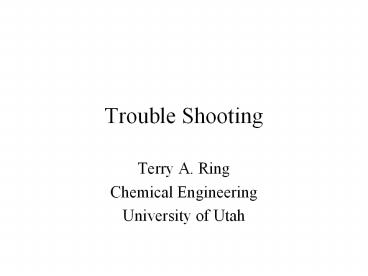Trouble Shooting - PowerPoint PPT Presentation
1 / 14
Title:
Trouble Shooting
Description:
Trouble Shooting Terry A. Ring Chemical Engineering University of Utah What is Trouble Shooting Problem solving process to find the root cause of a problem. – PowerPoint PPT presentation
Number of Views:208
Avg rating:3.0/5.0
Title: Trouble Shooting
1
Trouble Shooting
- Terry A. Ring
- Chemical Engineering
- University of Utah
2
What is Trouble Shooting
- Problem solving process to find the root cause of
a problem. - Trouble Shooting is not an exact science.
3
Try to Solve this problem
4
Costs for Analysis
- Action Cost
- Read meter 2 min.
- Check History 5 min
- Make Manual Measurement 30 min
- Adjust Operating Conditions 30 min
- Disassemble Equipment 4 hr
- Install new Equipment 5 day
5
Guidelines
6
Critical Thinking and Trouble Shooting
- Kepner-Tregoe (K-T) Strategy
- Clearly determine what is the problem
- Classification of problem into
- Do we need to determine the cause of the problem
- Do we need to make a decision on the problem
- Do we need to plan to avoid future problems
- Develop multiple approaches simultaneously
- Establish probability for success (and cost) of
each approach before proceeding - Know what a potential response to a question will
be under various problem scenarios.
7
Socratic Questioning
8
Kepner-Tregoe (K-T) Strategy
9
When asking question or asking for analysis
- What will I learn if I ask this question?
- How will I use this information to find the
fault? - Keep 4 or 5 working hypotheses at any one time.
10
K-T Analysis
11
K-T Potential Problem Analysis
Potential Problem Possible Cause Preventive Action Contingency Plan
A. 1. 2.
B. 1. 2.
12
Try to Solve this problem
13
K-T Analysis
14
Possible Faults with Similar Behavior
- 1) The steam trap is blocked causing liquid
condensate to back up in the heat exchanger so
the steam does not contact the pipes in the
exchanger. - 2) The entering water is sub-cooled.
- 3) The steam pressure and temperature have
dropped. - 4) The heat exchanger has become fouled.
- 5) The steam is dirty, i.e., contains non
condensable gases.






























